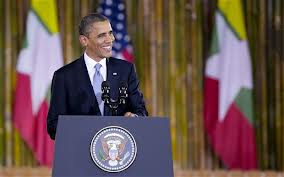12-18 November: “The Political Prisoners Game”
November 19, 2012 As US President Barack Obama visited Burma today, the Thein Sein government continues to pursue positive headlines in a cynical move to release political prisoners at the same time as Obama’s arrival.
As US President Barack Obama visited Burma today, the Thein Sein government continues to pursue positive headlines in a cynical move to release political prisoners at the same time as Obama’s arrival.
Last Thursday’s release of 452 prisoners was a huge disappointment as no political prisoners were among them, with the Assistance Association for Political Prisoners calling it “the worst amnesty ever”. Today, 19 November, however, at the time of publication 45 political prisoners have been released. This ploy by the government usually coincides with a visit of an international figure or a decision made by the international community on Burma. In September, 87 political prisoners were released the week before President Thein Sein went to New York for the UN General Assembly. In July, 25 political prisoners were released shortly before the US lifted its investment ban and Thein Sein met with US Secretary of State, Hillary Clinton, in Cambodia. This time, it is because President Obama is coming to Burma. “It seems there is a new game in Burma, which is the political prisoners game,” Phil Robertson from Human Rights Watch stated, highlighting the lack of integrity of these releases.
This public relations game is being further played with the beautification of Rangoon University. Historically very important as a centre of democratic opposition and student resistance, its physical condition has deteriorated dramatically since it was put into disuse in the 1990’s by the military regime. Thus, President Obama’s decision to make his speech there is highly symbolic and the government is desperately trying to put a new face on the university, painting buildings and clearing rubbish from its grounds. This is a kick in the face for those activists arrested in July who were planning a protest at the location of the student union building to mark 50 years since it was bombed by the army. It seems that when international attention is on Burma, the student union building is presented as an indictor of progress. But the hastily put up façade is a symbol of the depth of Burma’s reforms so far. If the student union building was a functioning, working institution, where students were allowed to gather and exchange views freely, this would be a real marker of progress.
If the government were serious about releasing political prisoners, they would have all been released by now. There are some positive signs from the government with the announcement that the International Committee for the Red Cross (ICRC) will be allowed greater access to assess the conditions inside Burma’s prisons as well as the intention to create review mechanism of prisoners deemed to be political. While this is encouraging it is wise to retain an element of caution. It has been over 18 months since Thein Sein started the reforms but there are still around 200 political prisoners in Burma. Furthermore, this review mechanism will only be effective and legitimate if it includes substantial involvement of non-government affiliated parties such as former political prisoners and organisations that work to help political prisoners. It is unclear if this will be implemented. A fundamental concern is that the only time this government seems to think of political prisoners is when Burma is in the spotlight and the government has something to gain from the international community.
News Highlights
Inside Burma
NLD faces internal criticism for being too ‘authoritarian’ as members quit
New report reveals that landmine fatalities rose to 84 people last year
Earthquake in northern Burma leaves 16 dead and many more injured with some still missing
PepsiCo holds talks to sign a bottling agreement
Regional
ASEAN adopts the ASEAN Human Rights Declaration despite criticisms
President Thein Sein to visit Cambodia for ASEAN conference as Cambodian authorities harass activists organising civil society forums ahead of the conference
International
UNHCR calls on Asian countries to open their doors to those fleeing violence in Arakan State
The UK government announces a package to support Internally Displaced Persons and refugees return
Opinion
Obama is Set to Visit Burma – But Will He Help the Tormented Rohingya People?
By Emanuel Stokes
The Independent
Myanmar: No Ethnics; No Nation
By Stanley Weiss and Tim Heinemann
Forbes
Actions
Mandalay residents evicted from their land 10 years ago are pushing for it to be returned
Statements and Press Releases
Civil Society Denounces Adoption of Flawed ASEAN Human Rights Declaration: AHRD falls far below international standards
By 55 National and Regional Civil Society Organizations
Civil Society Statement on Corporate Accountability in ASEAN
By 80 Civil Society Organizations in Southeast Asia
Open Letter Calling for the Establishment of a Review Mechanism for Prisoners
By Amnesty International
Asia Pacific Refugee Rights Network Statement on the Visit of the US President to Myanmar
By Asia Pacific Refugee Rights Network
Rohingyas Under Fear of Attacks Even Ahead President Obama Visit to Burma
By Burmese Rohingya Organization UK
Burma: CSW Urges President Obama to Encourage Further Reform, Raise Religious Freedom and Ethnic Conflicts as Priorities for Official Visit
By Christian Solidarity Worldwide
Burma: Obama Visit Underscores Rights Challenges
By Human Rights Watch
Burma: Satellite Images Show Widespread Attacks on Rohingya
By Human Rights Watch
Open Letter to President Obama
By Kachin Alliances
Open Letter to President Obama and President Thein Sein In Support of Peace, Reconciliation and Development in Myanmar
By Nobel Women’s Initiative
Statement from the Burma/Myanmar Delegation to the Solidarity for Asian Peoples Advocacy (SAPA) Workshops in Relation to the 21st ASEAN Summit in Cambodia
By Task Force on ASEAN and Burma
Open Letter to President Thein Sein Regarding Former and Current Political Prisoners in Burma
By The Best Friend Library
Reports
Myanmar: Storm Clouds on the Horizon
By International Crisis Group
This post is in: Weekly Highlights









 All posts
All posts